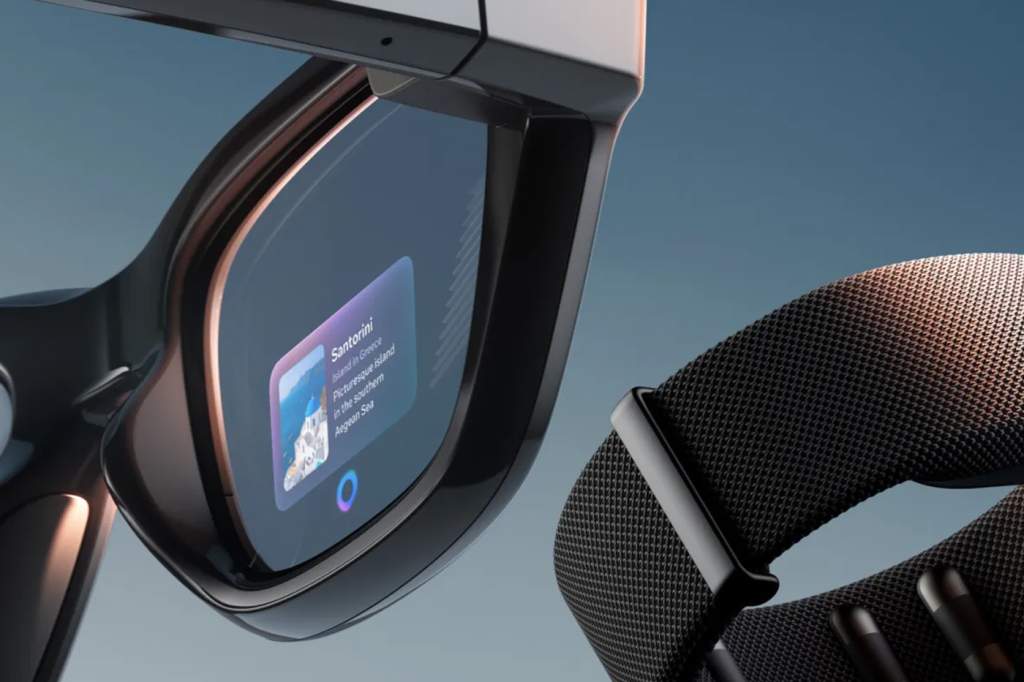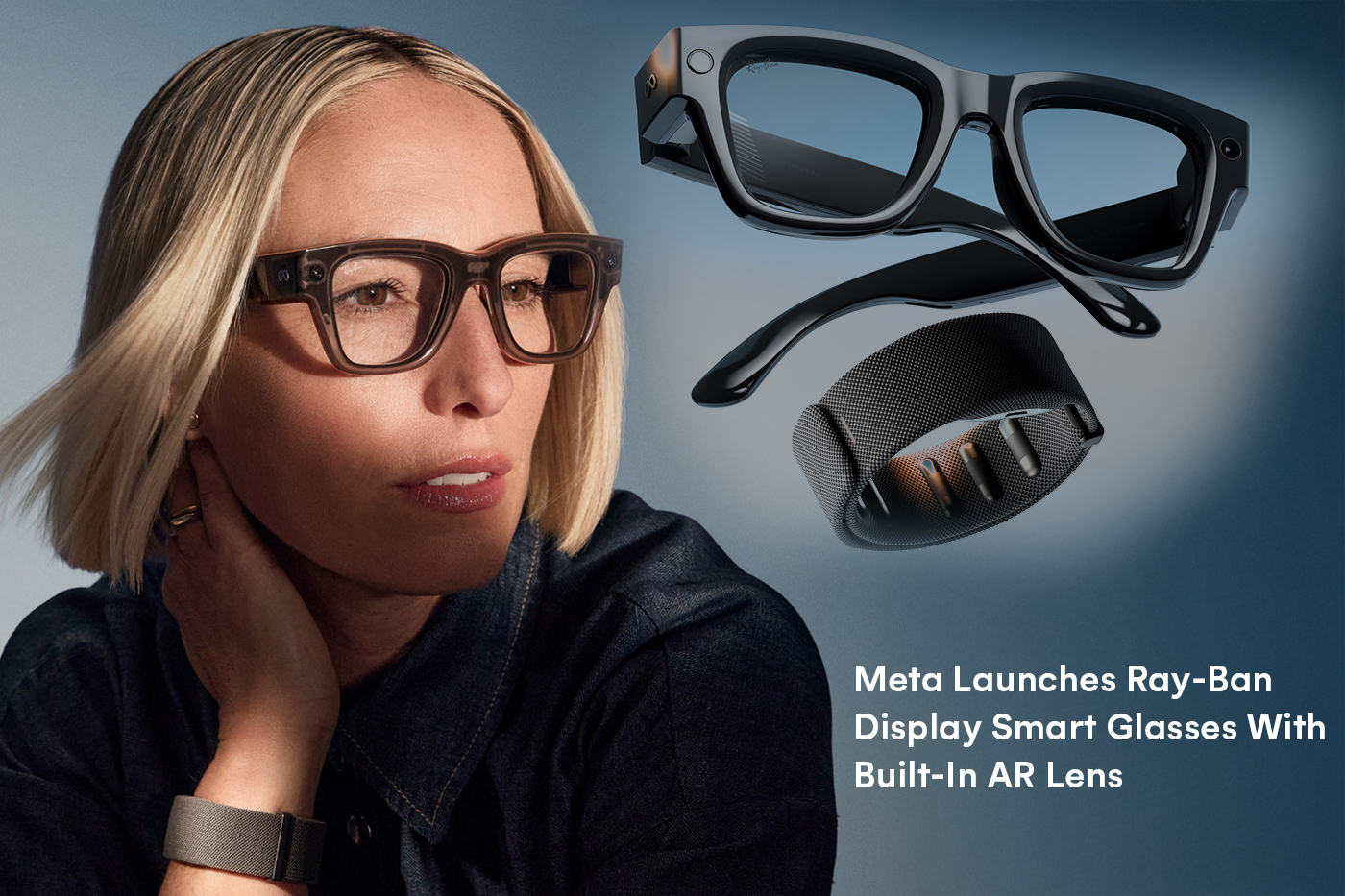Meta has quietly taken the wraps off its first advanced wearable, a pair of Ray-Ban smart glasses. Modeled on a pair of Wayfarers but packed with cutting-edge augmented reality technology, the new model represents a significant advance in the company’s vision to integrate digital information seamlessly into daily life.
In the US, they will cost $799 and will go on sale from September 30, 2025 with a wider launch in the UK, France, Italy and Canada early next year. An India launch date has not been confirmed yet, but industry watchers expect that to happen later in 2026 on account of Meta’s substantial number of users in the country.

Specs and Display Features
The Meta Ray-Ban Display smart glasses are the first to have an integrated AR display. Housed in the right lens, it displays text, images and videos a few inches below the user’s line of sight. This lets wearers receive navigation instructions, read translations and participate in video calls, all while leaving the phone in a pocket or backpack.
Besides the front and rear display, other glasses such as:
- Selfie Camera for Photos and Video Chat(live streaming).
- Open-ear speakers and microphones deliver premium audio clarity.
- Touch-sensitive arms and voice command compatibility with WhatsApp, Messenger and other Meta apps.
In addition, Meta has created a new kind of controller: the Neural Wristband, which is a water resistant bracelet that reads small electrical signals in the user’s arm. Using this technology, you can employ natural gesture controls like swipes, pinches and rotations resulting in an interface that feels more analog to simply tapping or swiping the glasses themselves.
Battery Life and Outdoor Visibility
Battery life frequently is a challenge for wearables. The Ray-Ban Display has a battery life on a full charge that lasts for about six hours of mixed usage, according to Meta. The charging case extends life another 30 hours, making the glasses much more practical for day-to-day use.
Another area of focus is outdoor visibility, a common frustration for AR displays. Though Meta has not provided specifications for how bright its projected display can become (or won’t share them as of this time), early testers claim the projected image is still visible even in direct sunlight, further enhancing usability over previous smart glasses efforts.
Meta Ray-Ban Display vs Ray-Ban Meta Gen2
The Ray-Ban Meta Gen2, released in 2024, received design praise for enhancing camera resolution and microphones, as well as extending battery life. But it still didn’t have an in-lens display.
Instead, the Ray-Ban Display simply does what the Gen2 could not: an honest-to-goodness AR experience that’s baked right into the glasses. It means, then, the Display is Meta’s flagship for those who want more than just camera-wearing eyewear. The trade-off here comes down to the fact that with both Gut2, you’re treated to a plain interface devoid of all visual layers so as not to interrupt an augmented reality app – Display debuts a full layer of visuals displayed for AR which makes it more advanced, and power-hungry in turn.
Privacy Concerns and Ethical Questions
With any smart-glass tech, there are privacy concerns. The Ray-Ban Display has an LED that lights up when the camera is in use, designed to let bystanders know they are being filmed. Critics say those indicators are easy to miss and do little to ease broader concerns over surveillance in public spaces.
The addition of a screen also creates new questions:
If private messages, directions or even translated phrases are only visible to the wearer, could that change how we interact with others?
Meta says that it’s committed to responsible technology design, but consumer advocates are likely to monitor how the glasses get used in everyday places.
Price, Availability, and Buying Options
America’s biggest meta fashion statement yet is here — and it has a release date. Meta Ray-Ban GlassGarfield eyes are so in right now, and if… The rollout will extend to the U.K., France, Italy and Canada in early 2026 with retail sales planned through Ray-Ban’s official stores, Meta’s online shop and select electronics retailers.
The company has not provided an official launch date in India, though the country is one of Meta’s top markets. Those glasses are expected by industry insiders to come between mid-to-late 2026 and being high-end options. Consumers are already asking “Where can I buy Meta Ray-Ban Display in the UK / USA / INDIA” so a strong international demand is apparent.
Are They Worth $799?
For some earlier adopters, the answer might be yes. It’s on the pricey side at $799, although the Meta Ray-Ban Display is a strong offer that many competitors can’t match.
The inclusion of an in-lens AR display, along with gesture-based control and integration with popular apps, makes it one of the most practical efforts yet to bring augmented reality to the masses.
However, questions remain. Battery life, though helped by the charging case, could still feel limiting to heavy users. Some consumers may be wary of privacy. And for anyone simply seeking a pair of glasses with camera functionality and style the Ray-Ban Meta Gen2 still remains a more economical option.
Outlook
The introduction of the Meta Ray-Ban Display smart glasses is a bold step in Maybe-In-The-Next-Couple-Years-Land, where Meta continues to fight to bring augmented reality into everyone’s regular routine. With a mix of recognizable Ray-Ban design and new futuristic capabilities like a heads-up display, wristband controls powered by neural tech and real-time translations the company is hoping to bet on a future where smart glasses are as ubiquitous in society as smartphones.
Whether that $799 price tag will be enough to dissuade people from participating is another matter entirely. But one thing remains true: with international launches slated for the US, UK and India, and growing concerns around privacy, outdoor visibility and responsible usage, discussions about the Ray-Ban Display just got a whole lot louder in 2025.












2 Comments
Comments are closed.